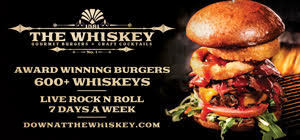When I told a friend that Il Mulino New York was opening a restaurant at the Swan and Dolphin hotel he said he couldn’t wait to go because the original – Il Mulino New York in New York – was his parents’ favorite restaurant when they lived there. Somehow, I don’t think they’d be quite as taken with the Central Florida version.
Oh, that’s not to say that it isn’t a good restaurant. It is. Most of the food I had during my two visits to the Swan’s newest signature restaurant was well prepared, and served by a staff that showed training if not consummate professionalism in an atmosphere that is large and bustling – yes, noisy — without being frantic, and stylishly modern but decidedly not cozy.
But it’s not the same as the original. I know this because following my two visits to the restaurant in the Swan hotel, I visited Il Mulino in Greenwich Village. It’s a small place with a neighborhood feel. The single dining room is tasteful and sedate and tables are covered with white cloths. In the center of the room is a table with a wheel of Parmigiano-Reggiano from which the waiter served chunks of the tangy cheese. There were also thin slices of salumi and toasted bread that positively oozed rich olive oil.
The entire Greenwich Village restaurant would fit in the bar area of Il Mulino New York in the Swan hotel. Which is why the word trattoria has been tacked onto the name. It emphasizes a less-upscale experience and removes the technicality of trying to be an exact duplicate.
Taken on its own merits and not as an outpost to an established restaurant, Il Mulino New York Trattoria is a good Italian restaurant. The menu focuses on, but doesn’t mind straying from, the Abruzzo region of Italy and ranges from seafoods of the coast to meats of the mountains, although the food here tends to go a little easy on the spicy-hot peppers that distinguish many of the dishes of Abruzzo.
My guest and I started our meal at the Swan’s Il Mulino with the misto di mare appetizer ($36), a cold platter of seafood for two. Firm, hefty shrimp, delicately tiny clams and sea-salty oysters were arranged beside a spiny whole langostine and a salad of squid, scallops and baby shrimp.
I followed with the pasta fagioli soup ($7), a big bowl of white beans and small pasta tubes in a broth that was slightly more tomatoey than other versions but not in an off-putting way.
I had dentice ($29) for my entrée, a seared red snapper cooked with sweet cherry tomatoes, salty pancetta and pungent garlic with a touch of white wine. The fish was a firm fillet with sweet tasting flesh that went well with the side dish of broccoli rabe.
My companion had the saltimbocca ($33), veal scaloppini sauteed with prosciutto and white wine and sage, served over fresh spinach. The meat was thin and tender and the sauce was tangy and rich.
On another visit my guest and I started with the insaccati misti ($24 for two), an antipasti platter of meats including prosciutto, mortadella and soprassata, and Parmigiano-Reggiano, roasted red peppers, sun-dried tomatoes and mozzarella.
For our primi course, we had half-orders of gnocchi Bolognese ($15) and risotto con funghi ($16). The gnocchi were firm and chewy potato dumplings in an intensely flavored meat sauce. The risotto had the delightful crunch of the arborio rice and the tender chew of the wild mushrooms in a broth that was tinged with truffle essence. Both were delicious.
We should have had the full orders and skipped the secondi. Both the vitello Milanese ($32) and pollo Parmigiana ($28) were disappointing. Both preparations involve pounded and breaded meats, and both were overcooked and hard. Even the brilliant taste of the fresh arugula on top of the veal couldn’t revive the dish.
For dessert, the torta di formaggio ($8) offered a twist on cheesecake, with a more crumbly, less cloying cake. Torta di cioccolati ($8) was a fairly average version of flourless chocolate cake. At the end of the meal, the server brought a tureen to the table and ladled tastes of limoncello into glasses for a sweet digestif.
Il Mulino New York took over the space of another Italian restaurant, Palio. The décor features wood floors and brick walls. Wood-topped tables are set with simple placemats instead of tablecloths. Domed light fictures that look like large heat lamps hang in clusters throughout the rooms. The kitchen is partially exposed, obscured enough so as not to dominate the scene but open enough to be a part of it.
Service was typically cheery although anything but prompt and efficient. The wine list has some wonderful selections that pair well with the food.
Il Mulino New York-Orlando and Il Mulino New York-New York share some similarities in the food – the oil-rich bread, the salumi and an identical pasta fagioli – but there are so many differences that one wonders if there is a reason the two share a name other than to exploit it. It would be a little like opening a chain of concert auditoriums seating thousands under the name La Scala. They could present opera performances, and some of them might be good. But somehow the experience just wouldn’t be the same.
Il Mulino
Written By Scott Joseph On May 29, 2007
FishBones
Written By Scott Joseph On May 1, 2007
FishBones, the 12-year-old seafood and steakhouse from Talk of the Town Restaurant Group, finally has a second location. Sort of.
For years there has been talk around town that Talk of the Town, which also operates the Charley’s Steak Houses, was shopping for a spot to put another FishBones. The original near the intersection of International Drive and Sand Lake Road has enjoyed much success, and the company’s MoonFish on Restaurant Row was too close to brand as FishBones.
So north they went to the Lake Mary district that is home to a cluster of other relocations, including Dexter’s, Harvey’s Bistro, Amura and, though it has now closed, Blackfin. All of these restaurants have something in common: the Lake Mary version bears little resemblance to the original. But for FishBones the dissimilarities are more marked. The décor is more upscale, the menu more extensive and even aspects of the service are different than the Sand Lake Road restaurant.
In fact, the only thing that is really the same is the name, and that still confounds people who confuse it with Bonefish.
Well, there is one other commonality: both restaurants serve excellent food. Whether it’s fish or meat you prefer, each is prepared expertly.
The Lake Mary FishBones impresses first with its size and splashy décor. It is easy to believe the rumors that put the price tag for the new restaurant somewhere around $6.5 million. There are multiple dining rooms as well as a sushi bar, indoor lounge and outdoor bar with tables that feature personal gas fireplaces. There are numerous display aquariums with exotic marine life plus a live fish tank for your dinner selections. Among the upscale decorations and touches of classiness are numerous glass works by Tampa artist Duncan McClellan. Directly behind the host stand is an immense wood-fired grill, which is something of a trademark in various Talk of the Town restaurants.
The sushi selections are listed as bait, an unfortunate pandering to those who think of raw fish only in derogative terms. My guests and I started with the sampler ($22.50) of California roll, yum yum roll and tuna toro nachos. The California roll distinguished itself with the inclusion of real crabmeat instead of the more usual surimi. The yum yum roll had flash-fried salmon, scallions and cool cream cheese. The nachos were the best of the platter, chips of nori topped with chopped tuna and a dollop of flying fish roe.
From the kitchen, fried calamari ($7.95) took on new dimensions with a variety of peppers tossed with the tender squid. Crispy almond fried lobster tail ($19.95) yielded precious little meat for the price, but what I was able to extract from the brittle shells was sweet and delicious.
I sampled a number of the fresh fish selections and each was as enjoyable as the next. Yellow edge black grouper ($25.95) had an enjoyable smoky note from the wood grill. Wild king salmon ($26.95), cooked on a plank, was moist and sweet. Hong Kong sea bass ($32.95) featured a fist-sized ball of white flesh graced with the salty tang of soy sauce.
Meat selections are given the same careful attention as the seafood. (The original menu listed seafood under the heading Fish and meat under Bones, hence the name.) One of my guests ordered the 24-ounce prime rib ($23.95), a startlingly huge hunk of meat that despite its size was tender and smooth-textured.
A new York strip ($21.95) had a beautifully charred crust and a warm, red, juicy interior. A side of bearnaise ($1.25), however, was poorly executed, as was the hollandaise that was first delivered by mistake.
Dinners include a house salad that is tossed tableside. Make that spun tableside. A metal bowl sits in a pan of ice and the server spins the bowl on the ice while pouring in the dressing. A gimmick, but an acceptable salad. By the way, at the Sand Lake FishBones the salad is delivered already plated.
Desserts were obscenely huge, which is not necessarily a good thing. Chocolate cake ($7.95) was dry and not particularly chocolatey, and cheesecake was fairly flavorless. We all enjoyed the sampler of sorbets ($5.95), even if they tasted more like ice cream.
Most of the servers showed training and professionalism, although one waiter pulled the old upgrade to a premium vodka when no preference is given trick. I’m beginning to think Grey Goose is behind this. There are a number of good wine selections to pair with either seafood or meat, but few bargains among them, an exception being a Wirra Wirra chardonnay for $6.95.
Following my two visits to Lake Mary I returned to the Sand Lake FishBones, which I had not visited since 1994. I was startled by the campiness of the décor, which features rod and reels in the rafters and laminated tabletops with maritime charts.
The menu did not feature sushi and several of the appetizer selections were unique, including alligator tail, which is undoubtedly there to appeal to the tourist trade. The calmari was markedly different, but the piece of black grouper I had was about as fine a piece of fish as I can recall.
Still, I think we should let the tourists and conventioneers have that FishBones. The drive to Lake Mary is worth it for the more welcoming atmosphere and larger menu. It may have taken 12 years for Talk of the Town to open a second FishBones, but along the way they learned a little more about what goes into a fine seafood restaurant.
Memories of India
Written By Scott Joseph On April 1, 2007
Bay Hill Plaza, the little strip mall on Turkey Lake Road in South Orlando, is turning into a mini World Showcase of international restaurants. There’s an Italian restaurant and market, Red Bamboo Vietnamese, A Taste of Japan, with sushi and other Japanese dinners, and 1-6-8 Chinese.
Also among the cosmopolitan collection is Memories of India, which has managed to pack an entire nation of flavors, textures and spices into a small but comfortable space. The food here is as good as any of the other fine Indian restaurants we’re lucky to have in the area, but the owners of MOI haven’t yet found it necessary to over-inflate the prices.
The menu takes favorite dishes from the various states of India and puts them together in a collection that is so enticing that just choosing one entree is too difficult.
One of my favorites among the many entrees was the chicken saagwala ($11.95), which featured tender chunks of chicken breast meat plus potatoes in a creamy curry made of spinach and spices. Even with the potatoes in the dish, rice is served as a vessel for carrying the meat and sauce. I just love getting double the starch, especially when it’s this good.
The rice, of course, is fluffy basmati rice, whose name means “queen of fragrance.” Basmati rice has a perfumery aroma and a nutty taste, and it’s generally cooked with a clove or two in the mix.
I also liked the lamb vindaloo ($12.95), cubes of lamb marinated in a vinegary gravy and cooked with potatoes and pearl onions in freshly ground spices. The vinegar marinade plus the pickled onions gave the dish a pungent flavor. The spice blend made it fiery hot. Vindaloos are the hottest of the Indian curry dishes.
By the way, I ordered all the spicy dishes medium-hot and found them to be plenty high on the heat scale. If you’re more timid, ask for the spicy dishes to be cooked mild. If you’ve got a death wish, go all the way.
Not all Indian dishes are hot and spicy. Take, for example, the delicious lamb korma ($12.95), which had the meat with green bell peppers, almonds and raisins in a milder, creamier gravy. Heavenly with some rice and some naan to soak up the sauce.
There are several vegetarian specialties on the menu. I sampled the aloo gobhi ($9.95), with big chunks of potatoes and cauliflowerets cooked in curry spices with onions and ginger. Meat was not missed.
Memories of India also features tandoori-cooked entrees, meats and fish roasted in a clay oven about three-feet deep. I went for the works and ordered the Bombay House mixed grill ($17.95), which included chicken — both the traditional red tandoori and marinated tikka varieties – lamb and shrimp. All the meats were moist and juicy, and they had plenty of flavor from the yogurt marinade. They were served with a mild curry and came with garlic naan, a flatbread topped with lots of fresh garlic. The naans are cooked by slapping the dough on the side of the oven wall, so they come out with a charred crust. Inside, however, the bread is soft and perfect for scooping.
For appetizers I recommend the nawabi lukme, or assorted platter ($8). This will get you plenty to sample, including samosas filled with potatoes and peas, pakoras dipped in chickpea batter and deep-fried, and lamb sheekh kabob, minced lamb grilled over charcoal. It all came with a chutney made with coriander, a pea-green dipping sauce that added a wonderful dimension to the meats.
For some reason a salad is included with the entrees, even though a salad course isn’t a traditional part of Indian meals. The simple plate of lettuce was drizzled with a creamy garlic dressing that was a little too strong. Stick with appetizers.
At meal’s end, there’s rice kheer ($2.95), a rice pudding with milk sugar, nuts and raisins, and handmade mango ice cream ($2.95), with a rich, pasty texture.
Service was affable and helpful. Wine and beer are available, including some Indian favorites.
The space, which was previously occupied by the now-defunct Lagniappe Cafe, is small but it has been tastefully decorated with wallpaper and wooden plaques depicting scenes of Indian peasant life. (The Shaq booth is no more.)
The lighting is subdued (except when the setting sun blares through the front door) and traditional Indian music plays quietly in the background. Seating is at tables and booths that are covered with white and pink cloths, topped with glass.
Memories of India is a delightful restaurant, one with delicious food and a pleasant staff. Even if our travels have not taken you to Asia, you’re sure to leave here with some fond memories of your own.
Polonia
Written By Scott Joseph On March 5, 2007
When the Polonia Polish restaurant sign went up on US 17-92, old fans breathlessly hoped that it was the same folks who had won their hearts and bellies at the similarly named restaurant from Winter Park. It is.
Owner Rob Plummer told me by phone that he had to close the restaurant on Aloma because his chef went back to Poland. But the chef is back and all is well again.
You don’t have to be Polish to admire Polish food. You need only an appreciation for hearty fare whose origins come from the necessity to make do with what the earth and the seasons give you. This is farmland food, Eastern European style, where root vegetables like beets and carrots, and cured meats like kielbasa are used in abundance. And simple ingredients like flour, water and potatoes can be turned into something as splendid as pierogi.
And this is where something with a reputation as unflattering as a stuffed cabbage can be made into a delicacy that will change your mind about it forever.
Golabki, pronounced gowamki, is the name for the stuffed cabbage ($7.95). The pungent leaves were filled with a mixture of ground beef, pork and rice and covered with a tangy sauce of tomatoes. If you prefer, a mushroom sauce may be substituted.
Polonia features two types of pierogi ($7.50), the filled dumplings that are a staple of a Polish meal. You can get them with sauerkraut and mushroom or with potatoes and farmer cheese. Either version will be served topped with butter and covered with sweet caramelized onions and finished with a creamy dollop of sour cream. I liked both versions although I would probably tip the scales in favor of the potato filling because it seemed like a more substantial entrée.
One of my favorite dishes was the veal cutlet ($12.95). My guests and I could hear the cook in the kitchen pounding the cutlet, which was then coated with a breading and sauteed. The breading came out as crisp as you please, and the buttery taste was a perfect accent to the creamy veal.
Both the beef goulash ($11.95) and chicken paprikash ($9.95) were mildly flavored. That’s not so unusual for the goulash but the paprikash should show more seasoning. The goulash featured chunks of beef simmered in red wine with carrots and shallots. The chicken was simmered with vegetables and was sufficiently moist and tender.
If you have a hard time deciding what to order, consider the big Polish platter ($9.95), which isn’t really all that big but does tender ample portions of stuffed cabbage, kielbasa and pierogi with mashed potatoes and Polish kraut.
Other entrees come with a choice of two sides. The beets were fairly mild and the carrots rather dull. The sauerkraut was good and so was the cucumber dill salad with its sweet sauce. My favorite was the potato dumplings, dense rolls of potato flour with a smooth texture.
If you really want beets order the borscht ($3.50), arguably Poland’s most popular soup, with its red beety broth and shreds of the root vegetable. The soup is served hot with a plop of sour cream.
Zurek ($3.50) is another popular soup from Poland. Known also as Easter soup, it has sour rye flour as its base and is seasoned with fresh garlic and marjoram. Two halves of a hard-boiled egg float in the murky broth and feathery leaves of freshly chopped dill float on top.
For dessert there poppy seed cake ($), a multi-layered affair of chocolate with sweet vanilla frosting and hundreds of poppy seeds. Apple strudel ($) and blintzes ($) are as equally good as the cake.
Polonia is housed in a standalone building that at one time was a fast-food restaurant of some sort. (The abandoned drive-through lane is still there.) Most recently it was home to an Asian restaurant, and there is what may have been a make-do sushi bar next to the deli counter. The small dining room is rather plain, with white walls decorated with a couple of colorful Polish costumes and undistinguished paintings. The center of the room has what appears to be a dance floor, although no one moved the tables away to polka to the music that was playing. Tables are uncovered and napkins are of the paper variety.
No, this is not a fancy dining experience. But for those who enjoy good Polish food it’s as fine as it gets.
Kres Chophouse
Written By Scott Joseph On July 15, 2006
Kres Chophouse has been holding its own in downtown Orlando, good times and bad, for a good number of years now. Downtowners like its “adult” mien, a classy spot amid the myriad kids’ hangouts.
As with any chophouse, meat is the main event. On my first visit I went right to the top and ordered the veal rib chop ($32). It was a beautiful hunk of meat and seemingly larger than its advertised 12 ounces. And once I sent it back to be cooked, it proved to be just as tasty as it looked.
My guest had the mixed grill ($29), which combined garlic shrimp, filet mignon and double lamb chops, and all were properly cooked and delicious.
On another visit I sampled the twin filet mignon Oscar ($28), two aptly named tenderloins, seared to the requested medium-rare — first time — and topped with a smidgen of king crab meat and a bearnaise. The sauce wasn’t quite what it should have been, but it was a nice entree, especially with the included blue cheese au gratin potatoes.
One of my guests had the beef Wellington ($32), a filet mignon topped with a sliver of foie gras and wrapped in puffed pastry. While the meat was properly cooked, the pastry was a bit doughy. But a mushroom ragout, asparagus and more of the blue cheese potatoes made everything better. By the way, with most dishes coming with side items, I was curious why there was an a la carte list of vegetables and potatoes, each $5. Based on the creamed spinach I sampled, which wasn’t quite creamed, I’d stick with what they give you on the plate.
Another guest had pompano en parchment ($27), which had a fillet and scallops with hearts of palm inside a parchment wrapper. Unfortunately the steaming overcooked the fish and it came out mushy.
I was happy to see steak tartare ($15) on the appetizer menu, but was disappointed with the runny, over seasoned glop. Grilled lemon garlic shrimp ($12) were tasty if a tad overpriced. The simple beefsteak tomato with buffalo mozzarella ($9) was a more satisfying starter, especially with a sprinkle of salt to offset the sweetness of the balsamic vinaigrette.
For dessert there was a rather odd Key lime concoction ($6) served in a glass, and a sweet and piquant apple tart ($6).
Service was good, nonintrusive. The wine list has several appropriate selections, a number of them by the glass.
The layout of the space is long and narrow with 22-foot ceilings and a bar and dining area on multi levels – but it has been reimagined by the same designer who did Hue. Hue was a new construction while Kres occupies a decades-old room, so some of the modern designer touches seem strange next to the original architecture. There are splashes of red — extremely high booth backs in particular — against brown walls. A wide wood-slat basket-weave banister separates the bar from the dining area.
A diaphanous curtain drapes off a private dining area at the rear of the room. The curtain is a robin’s egg blue and matches the color of the painted ceiling panels. Imposing light boxes hang from the ceiling. They replace the Bali-esque flying ladies that were the holdover from a restaurant that opened in 1989.
That place was called Bailey’s Cityside, a version of a then-popular Winter Park eatery. The owners had thought downtown Orlando was about to take off. They were about 15 years ahead of their time.
Kres is at









